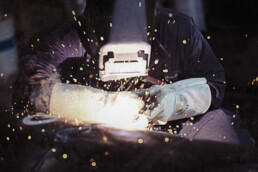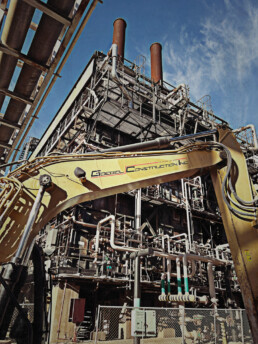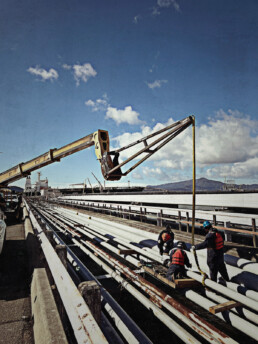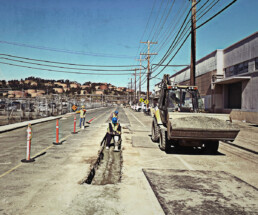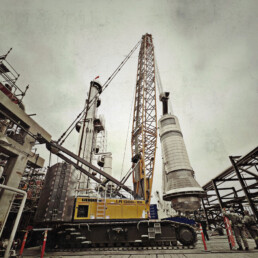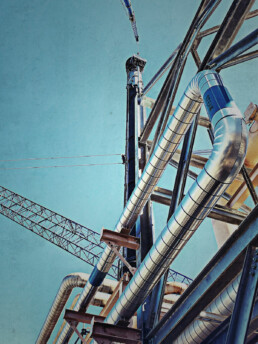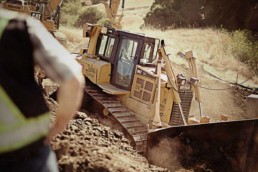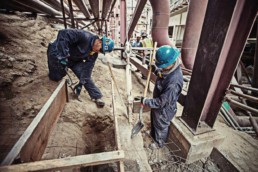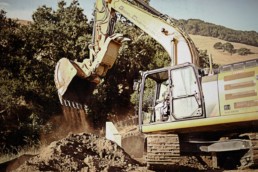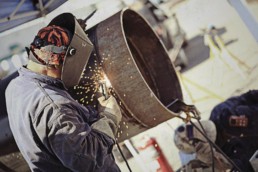Chevron Refinery Support Team
Chevron Refinery Support Team
CHEVRON REFINERY
Project Value: $1.6 Million
Background
Due to Major Turnaround and other events requiring a multitude of Chevron personnel. The Chevron Refinery required a support team at the boiler shop to backfill the maintenance projects around the refinery.
Scope
- Direct Communication with Rep to devise safe and efficient work plans
- Field Welding + Installation of Spools
- Wide variety of piping classes used
- Daily communication with Reps
- Daily QA/QC doc submittals
- Variety of SMAW, GTAW, alloy, structural, and specialty weld procedures
- Field Verification and Work with DED for changes.
- Pipe and Structure Prefab
Project Highlights
- Team of problem solvers in order to complete projects in a timely manner
- Projects included hot taps, steam systems and fresh air jobs
- Projects could change daily
Challenges
The support team is tasked with completing projects that could change daily. Because of the scope and timeframe of projects, there is limited time to plan. When planning, we must consider the skillsets required to complete the assigned tasks.
Solutions
Effective communication was crucial for the successful completion of tasks safely and on time. It was important for shop representatives, Goebel Construction management, and the field crew to collaborate and understand the tasks to be completed. As well as the available resources, such as the manpower, to ensure the necessary skillset was available. By having a clear understanding of the project, we were able to plan accordingly to ensure that everything was completed efficiently.
Project Success
Owing to the success of management and the field crew’s ability to showcase a broad range of skills to complete tasks. The 4–6-week project got extended to 6 months. By the completion of the project, there was a total of 9,403 safely worked man-hours.
Firewater Line Replacement
Firewater Line Replacement
CHEVRON REFINERY
Project Value: $1.2 Million
Background
The Firewater Line replacement program was a complex project involving civil and mechanical scopes. The project included the replacement of the existing line, which required extensive excavation, sand backfill, and paving.
Scope
- Project management: set-up, and mobilization.
- Material procurement as shown in specifications and contractor workbook
- Fire-watches
- Traffic control
- Excavation, sand backfill, and paving
- Trench plates
- Layout and weld-bay piping prefabrication
- Field piping fabrication, hydro-testing, installation, and tie-ins
- Coat and wrap underground CS piping and flanges
- Guard post installation
- QAQC and document submittals
- Clean-up and demobilization
Project Highlights
- Completed 150 carbon steel welds
- Completed 76 HDPE fusion welds
- Installed 475LF of HDPE pipe
- Excavated 270 cu yd of material
- Imported 250 tons of clean rock fill, 110 tons of sand fill and 150 tons of aggregate base rock
- Import level and compact 60 tons of asphaltic concrete paving
- Coordinated excavation and mechanical scope to limit the risk of open dig sites
Challenges & Solutions
The firewater line project required being set underneath an operational street. Due to the activity of the street, it needed to be open for traffic during non-construction hours.
During the project, we encountered multiple subsurface obstructions. There was also a high-water table that could affect the excavation and installation of the new line.
With great coordination between the team, we were able to restore the roadway daily with trench plates and shoring to keep the road operational after hours.
With multiple obstructions found, we recommended and installed various piping modifications to the firewater line. Due to the high-water table, we ran pumps to pull out excess water to be able to continue work.
Project Success
Successfully completed the project with a recorded 13,500 safe man-hours worked.
Long Wharf Sanitary Sewer Replacement
Long Wharf Sanitary Sewer Replacement
CHEVRON REFINERY
Project Value: $4.6 Million
Background
The existing sewer system was at the end of service (EOS). Requested by client, Chevron, to develop and execute a replacement plan.
Scope
- Demolish the existing 7500LF carbon steel piping system which included:
-
- Complete system flush with fresh water
- Insolation, drain down, and blinding
- Saw cut and removal of piping
-
- Installation of 3 new septic tanks and pumps which included:
-
- Vendor fabrication
- Pre-engineered support system
-
- Fabrication and installation of a new 7500LF carbon steel piping system which included:
-
- 1000+ welds that required 100% NDE
- 75+ tie-ins into the existing facilities
- 75+ suspended work platforms
- Hand rigging
- Crane and rigging
- Structural steel modifications and installation
-
- Provided all QAQC which includes:
-
- Welder Qualification
- Material MTR’s
- 100% NDE
- Weld mapping
- Strength test of all piping systems
- Flange torque and reports
- As-built drawings
-
- Provide all management, field supervision, labor, equipment, and materials.
Project Highlights
- Construction was completed without one environmental incident.
- Client requested and relied on GCI’s construction and engineering capabilities to successfully complete this project.
Challenges & Solutions
- Entire project was over water. Nothing in our construction process could enter the bay.
-
- GCI developed and executed a site-specific plan to meet this requirement.
- Plan was executed 100% successfully.
-
- All flanged connections required double containment.
-
- GCI developed the containment system.
- System showed a project cost saving of $250,000
-
- Three new septic tanks/pumps were required for this project.
-
- GCI developed the installation location and pre-engineered support system.
-
- Work had to be planned and completed in conjunction with a fully operational wharf with heavy ship traffic.
Project Success
Logistically difficult project that was completed on time without any disruptions to product deliveries or environment.
Calol St. Sanitary Sewer Replacement
Calol St. Sanitary Sewer Replacement
CHEVRON REFINERY
Project Value: $1.8 Million
Background
The project entailed installing approximately 750 LF of HDPE sanitary sewer system on Calol Street for Chevron. The scope included the installation of new sanitary sewer pipelines, manholes, cleanouts, and tie-ins. Calol Street required excavation in multiple phases to install new HPDE sanitary sewer line and manholes.
Scope
- Excavating
- Trenching
- Piping
- Paving
- Underground
- Tie-ins
- Demolition
- Grading
- Sewer System (MHLS)
- Safety: Traffic attendants
Project Highlights
- Installation of 750LF of 12” HDPE sewer line
- Removed 1500 tons of soil during excavation
- Successful tie-in to existing facility sewers and drains
- Multitude of subsurface obstructions (abandoned lines, concrete guy foundations, unmarked duct banks, wood dunnage, etc.)
- Locate and tie-in additional drain lines
- Tie-into existing 6” force-fed sewer
- Working with live lines
Challenges & Solutions
- Multitude of subsurface obstructions which required extra planning to reroute and/or demo obstructions
- Locate and tie-in additional unplanned drain lines
- Tie-into existing 6” force-fed sewer
- Correct flow maintained amongst countless subsurface obstructions encountered due to critical and creative field thinking
Crafts Supported
- Laborers
- Operators
Project Success
Completed the 9,200 man hour project with no recordable injuries while working on an operational road. Excavation scope was successfully completed without damaging any underground obstructions.
RLOP Turnaround
RLOP Turnaround
CHEVRON REFINERY
Background
During the 4th Quarter of 2022, Goebel Construction executed a Turnaround Event on Chevron’s Richmond’s Lube Oil Plant (RLOP) unit. Considered a Major Turnaround Event by the client, they entrusted Goebel to provide numerous services including mechanical piping, civil construction, and labor support.
Crafts Supported
- Pipefitters
- Laborers
- QC Technician
- Operators
Services Performed
- Pipe Replacement
- Temporary Piping
- Foundation Anchor Bolt Replacement
- Sour Water Piping Replacement
- Pipe Repair
- Grouting of Column and Flare Bases
- Valve Changes
- Relief Blowdown Piping
- Pipe Detailing
- Safety Attendants
- PRD Replacement
- Pipe Prefabrication
- Labor Ground Support
- Condensate Pipe Replacement
- Paving
- Earthmoving
FCC Turnaround Project
FCC Turnaround Project
CHEVRON REFINERY
Background
During the 4th Quarter of 2020, Goebel Construction executed a Turnaround Event on Chevron’s Fluid Catalytic Cracking (FCC) unit. Considered a Major Turnaround Event by the client, they entrusted Goebel to provide numerous services including mechanical piping, civil construction, and labor support.
Project Highlights
- Started and completed during the height of the pandemic
- Pre-turnaround activities: 50,000 hrs.
- Turnaround man-hours, during execution (60-day duration): 100,000 hrs.
- Total man-hours: 150,000
- 465 weld count
- 706 bolt ups
- 7,000 tons earth moved
- 0 recordable injuries
- Project came in under budget and ahead of schedule
Scope
- Detailing and prefabrication of process piping spools
- Temporary piping installation and removal
- Isolation and blinding of unit
- Piping removal and replacement
- Valve changes
- PRD replacement
- Flare piping removal and re-installation
- Cooling tower cleanup
- Import and removal of 3,500 tons of fill for temporary crane pad construction
- Anchor bolt and foundation replacement
- Grout column and flare bases
- Structural steel installation and repair
- Labor ground support
- Safety attendants (fire watch/hole watch)
Crafts Supported
- Pipefitters
- Laborers
- Operators
- Iron Workers
Oxidation Pond Closure
Oxidation Pond Closure
CHEVRON ENVIRONMENTAL MANAGEMENT COMPANY
Project Value: $12 Million
Scope
Cap and Title 27 closure for a former 66-acre oxidation pond system. At the time, this was the largest active Title 27 Closure project in the United States.
- Remediation
- Grading
- Paving
- Underground
- Earthmoving
- Soil mixing
Challenge
We needed to solidify and stabilize F037 waste sediments in large inaccessible pond cells to suspend contaminants as well as create usable area for the facility owner. Twenty acres were designed as a “floating cap” where only the top three feet of sediment were stabilized and encapsulated the remaining sediment below.
Solution
We designed direct pneumatic delivery and placement of Portland Cement and Fly-ash to cells and direct placed soil amendments. This eliminated the need for on-site silo storage and secondary delivery operations of cementitious materials. We used GPS guided equipment to grade and place subgrade and finish surface of aggregate base rock, reducing the personnel required for the task.
Project Success
We completed the closure ahead of schedule and under budget. Our innovative approach resulted in a client cost savings of over $2.5 million and reduced risk exposure.
Substation Infrastructure
Substation Infrastructure
CHEVRON REFINERY
Project Value: $3 Million
Scope
Site work and foundations for new substation and electrical distribution infrastructure. Included Installation of power poles and conduit to support construction of new substation.
- Earth Moving
- Grading
- Paving
- Underground
- Masonry
- Mechanical Piping
Challenge
Substation site was in an inaccessible hillside behind a main active refinery pipeway.
Solution
We constructed temporary access over the pipeway for mass excavation and construction of a 35-foot tie-back wall and secondary wall. Because of the topography and site access, we excavated and sloped the entire slope, constructed the wall to full height, drilled tiebacks then installed and tensioned through the new wall in concert with the wall backfill. We removed the old pipeway for access and constructed a new pipeway above and around the substation — completing the piping tie-ins without disrupting refinery operations.
Multiple power pole foundations of differing designs for the main feeder were constructed for the 115Kv feeder lines into the substation, some up to 10 feet in diameter and more than 40 feet deep and others being large pile-supported concrete foundations with 15 to 20 piles each. We constructed all underground duct banks as well as the elevated substation foundation and associated structural steel. New distribution pole foundations were constructed, again with some being large deep drilled piers and other being pile-supported hollow concrete poles.
Project Success
Provided constructibility for routing of new pipeway, allowing us to successfully transition into construction of the actual substation.
Quarry Firewater
Quarry Firewater
CHEVRON REFINERY
Project Value: $5 Million
Scope
Tank Site Work which included removal of 300,000 cubic yards of hillside, processing of removed material and re-installation of processed material to facilitate new quarry firewater tank.
- Earth Moving
- Grading
- Paving
- Underground
- Masonry
- Mechanical Piping
Challenge
The client had selected a location for the new firewater tank to maintain proper pressures to the refinery firewater system without the addition of pumps. Engineering asked us for constructibility of new foundation and execution.
Solution
While the original design showed removing hillside and importing new structural fill material from local quarries for the foundation, we processed the existing removed material for uses as the structural fill.
Project Success
Our innovative approach resulted in a client cost savings of $2 million.
CVX/EBMUD RO Plant
CVX/EBMUD RO Plant
CHEVRON REFINERY
Project Value: $4 Million
Scope
Expand plant to receive and process EBMUD reverse osmosis water.
Challenge
We needed to install 3,500LF of 316 stainless steel pipe from EBMUD to Chevron’s treatment facility. This work included site excavation and grading, concrete foundations, installation of pumps and filter, pipe racks and critical tie-ins during the plant shutdown.
Solution
Before construction began, we noticed the project was designed with a standard sewer system. We helped redesign and construct a sewer system that met process refinery requirements.
Project Success
We completed the project on time, under budget and 100% injury-free. Plants were able to receive, treat and use most all of the Richmond plant outfall waste, which reduced or eliminated discharge to the San Francisco bay.
